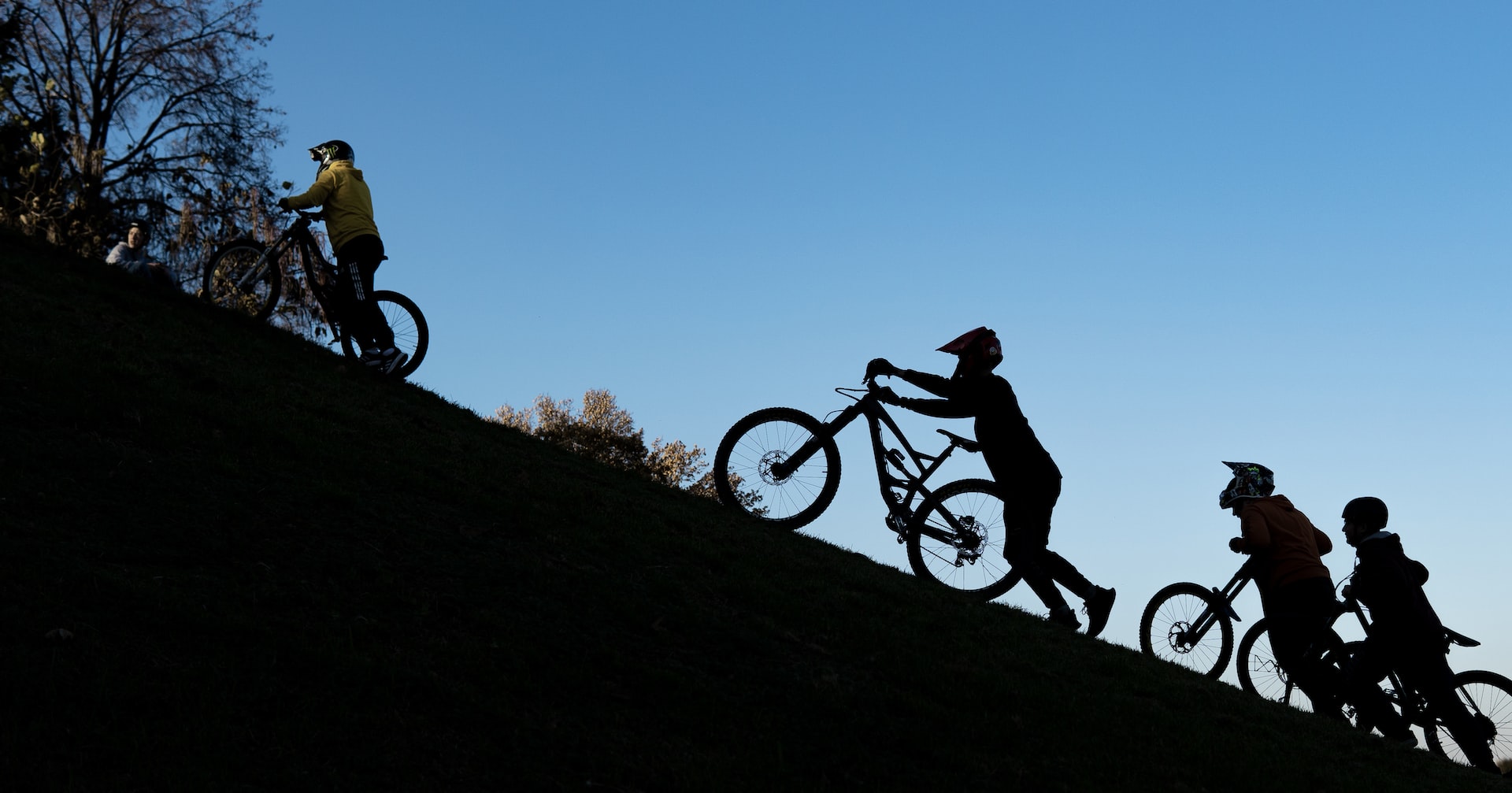Hitting the trails can be one of the most rewarding and therapeutic activities, whether backpacking over vast mountain ranges or running along winding single-track trails. A muscular body and good endurance will help you reach your goals and enjoy your days in nature. While getting out on the track can help build muscle and perseverance, the best way to improve your trail performance is to complement your outdoor time with the right exercises. This article will outline the best activities to build the strength, power, and endurance necessary for tackling the trails.
Strengthening Exercises
Strength training is an essential component of a healthy trail-running routine. Muscular strength improves stability, balance, and power on the trail and increases your overall endurance. Here are some of the best strength-training exercises to help you improve your performance on the course.
Squats
Squats are essential for strengthening your muscles, especially those in your lower body. Trail running involves many up and down hills, so having strong muscles in your legs and core is essential. Start by standing with your feet shoulder-width apart, and slowly bend your knees as if sitting in a chair. Lower your body down until your thighs are parallel to the floor. Make sure to keep your back straight and your core engaged. Pause for a few seconds, then slowly return to the starting position. Do three sets of 10 repetitions.
Lunges
Lunges are a great way to strengthen your quadriceps and glutes, which are essential for running. Stand with your feet together and take a big step forward with your right foot. Bend both knees to lower your body until your front thigh is parallel with the ground and your back knee almost touches the floor. Push off with your front foot to return to standing. Complete ten reps on each side.
Calf Raises
Calf raises are essential for strengthening the muscles in your calves, which are necessary for running up and down hills. Stand on the edge of a stair and hold onto the railing for balance. Lift your heels off the edge of the stair and hold for a few seconds. Lower your heels until you feel a stretch in your calves. Do three sets of 10 reps.
Planks
Planks are a great way to build core and back strength, which is essential for trail running. Start by lying on your stomach and propping yourself on your elbows and toes. Engage your body and hold the position for 30 seconds, keeping your hips and lower back stable. Rest for a few seconds and repeat three times.
Strength-training exercises can help improve your performance on the trail and reduce your risk of injury. These exercises can be done at home or in a gym and are a great way to build strength and endurance. Do these exercises regularly, and you’ll significantly improve your trail-running performance.
Cardio Exercises
Cardiovascular exercise is an integral part of the equation when you’re looking to increase your performance on the trail. Trail running and hiking are cardiovascular exercises, but adding specific cardiovascular workouts can help you improve your endurance, strength, and speed. Whether you’re a beginner looking to build up your fitness base or an experienced trail runner looking to up your game, here are some of the best cardio exercises to improve your performance on the trail.
Interval Training
Interval training is a great way to increase your endurance on the trail. All you need is a flat area with room to move, and you can run, sprint, or jog for several minutes at a time, with a short rest in between. For example, you could run for 2 minutes, walk for 1 minute, and repeat for 20 minutes. Interval training is excellent for building your speed and endurance, and it’s relatively easy to fit into your routine.
Hill Climbs
Hill climbs are a great way to increase your strength and improve your trail performance. Any hill at least a quarter of a mile long will work, so you don’t necessarily need to find a steep mountain. Find a good hill, and slowly increase your speed as you climb. Use the downhill portion for recovery, and then repeat for about 20 minutes. As you become fitter and more robust, you can increase the speed and duration of your hill climb workouts.
Jumping Rope
Jumping rope is a classic cardio exercise that boxers and athletes have long used. The jumping motion helps build strength, cardiovascular endurance, agility, and balance. If you don’t have access to a jump rope, you can still do the same exercise by hopping over an imaginary rope or by running in place. Try jumping for at least 10 minutes, and stop if you feel tired.
Bodyweight Circuits
Bodyweight circuits are another great way to build strength and endurance. All you need is some open space and your body weight. Circuit training combines cardio and strength exercises that involve quick bursts of energy. For example, you could do ten push-ups, ten burpees, and ten squats, then rest for 1 minute and repeat. This is a great workout to include in your routine if you want to increase your strength and endurance.
Cardiovascular exercise is an integral part of any trail runner’s routine, and these exercises can help you become faster and fitter on the trail. Whether you’re looking for a quick burst of energy or a longer workout, there is a cardio exercise that can help you improve your performance. Adding interval training, hill climbs, jumping rope, and bodyweight circuits to your routine can increase your strength, endurance, and speed on the trail.
Improving Balance
For individuals looking to improve their performance on the trail, focusing on one area can help, but improving their overall trail performance should be the ultimate goal. Enhancing overall trail performance means concentrating on various locations, including flexibility, strength, balance, and endurance. This section will provide exercises and tips to help improve all of these areas, ultimately improving performance on the trail.
Improving Flexibility
Achieving good flexibility can help improve performance on the trail by helping the body better cope with the varied terrain, reducing the risk of injury, and helping to improve balance over treacherous terrain. Some great exercises to help improve flexibility for trail runners include:
• Dynamic stretches: These are stretches done while moving, such as side-to-side lunges.
• Yoga: Partnering yoga with a running program improves overall flexibility. Yoga helps to improve the range of motion and balance and helps the body become more aware of itself.
• Body rollers: Using a foam body roller on the calves and quadriceps can help to improve flexibility and reduce the tightness that can build up due to running.
Strength Training
Strength training is another critical factor that helps to improve trail performance. While running can help build strength, it is vital to pair running with strength training exercises to help optimize performance on the trail. Furthermore, strength training helps improve endurance and recovery time and reduce the risk of injury.
Many different types of strength training exercises can be used to improve performance on the trail, but some of the best activities include:
• Squats: Squats are great for strengthening the quadriceps, glutes, and hamstrings, which are crucial for performance on the trail.
• Push-ups: Push-ups help to build core strength, which is necessary for climbing and navigating rugged terrain.
• Lunges: Lunges are great for building strength and balance in the legs, which are both necessary for navigating uneven terrain.
• Weighted exercises: Weighted exercises such as walking lunges with weights can help to improve overall strength, stability, and balance.
Increasing Balance
Improving balance on the trail is essential for navigating uneven terrain and reducing the risk of injury. Many exercises and activities can be done to help improve balance and coordination. These include:
• One-legged exercises: One-legged squats and one-legged deadlifts improve balance and coordination.
• Obstacle courses: Setting up an obstacle course in an outdoor area can help to improve coordination and balance. Cones, logs, and other objects can help simulate the trail’s terrain.
• Yoga: Yoga is excellent for improving balance and coordination. Yoga poses such as tree pose and warrior III will help to improve balance, as well as strength and flexibility.
• Balance boards: Using a balance board or wobble board can help to increase balance and coordination.
By improving overall performance on the trail, rather than just one area, individuals can maximize their performance and reduce the risk of injury. Individuals can enhance their performance on the track by incorporating strength training, flexibility, and balance exercises into their training program.
Building Endurance
If you’re looking for the best exercises to improve your performance on the trail, you need to focus on building endurance. Enhancing your stamina is essential for tackling long-distance hikes and running and can help you push yourself further during exercise.
Develop Strength and Endurance in the Gym
Heading to the gym is a great way to build strength and improve endurance. Choose exercises that use all your major muscle groups, using both bodyweight and resistance exercises. This helps to develop and maintain your muscular strength, which can help you on the trail. Examples of activities you might want to consider include squats, lunges, push-ups, burpees, tricep dips, bicep curls, and shoulder presses.
Go Long on Cardio
Cardiovascular exercises such as running, biking, or swimming are also essential for improving your endurance. Aim to work out more at a moderate intensity rather than shorter, more intense sessions. Doing this will help your body become accustomed to exercising for extended periods and increase your overall endurance.
Incorporate Intervals
Interval training is a valuable tool for boosting your performance on the trail. Interval training involves short, intense exercise bursts followed by short rest periods. This type of training helps you to push through your physical and mental limits and can help increase stamina.
Try Hill Sprints
If you’re looking for an even more intense way to build your endurance, then hill sprints are the way to go. Find a big hill or incline, and then, after warming up, sprint as hard as you can for a few seconds before jogging back down. Repeat this several times, and you’ll notice an improvement in your stamina and endurance.
Building endurance on the trail can be challenging, but you can make significant progress quickly with the right exercises. Have fun, and keep your mind and body in top form.
Developing Focus
Trail running requires focus and dedication to achieve success. Developing focus involves understanding the physical and mental demands of trail running and committing to practice the right exercises. The following activities can help you improve your focus on the trail and maximize your performance.
Improving Mental Focus
Mental focus is an essential component of successful trail running. To improve your mental focus, visualize your course and practice mental rehearsal. Visualization involves imagining yourself running on the trail, anticipating the terrain and obstacles, and feeling the sensation of running before you ever start. Mental rehearsal is a technique that helps build confidence and focus by imagining yourself running and successfully overcoming the challenges of the course.
Strength Training for Trail Running
Strength training is an integral part of a trail runner’s workout routine. To develop the strength and agility you need for trail running, focus on exercises that target your core muscles, like planks, medicine ball throws, and squats. Additionally, activities that improve your balance and coordination, such as single-leg box jumps, can help you navigate the technical, uneven terrain of the trail.
Endurance Exercises for Trail Running
Endurance is a crucial factor in successful trail running and requires regular practice. To improve your endurance, focus on exercises that increase your aerobic capacities, like interval training, hill sprints, and long-distance runs. Additionally, endurance exercises that focus on strengthening your legs, such as stair climbing, are beneficial for trail running.
Dynamic Exercises for Trail Running
Dynamic exercises are a great way to develop balance, agility, and coordination, which are essential for trail running. Lunges, high knees, and lateral shuffles simulate the dynamic movements of trail running. Additionally, jumping exercises, like box jumps and bounding, can help you develop the power and agility needed for running uphill and jumping over obstacles.
By practicing the right exercises, you can develop the physical and mental strength needed to improve your performance on the trail. You can maximize your potential and enjoy the rewards of successful trail running with focus and dedication.
Stretching
Stretching is one of the most critical exercises before a trail run. Not only does it help warm up and loosen the muscles, but it also improves performance on the trail and reduces the chances of an injury. Dynamic stretching, which involves active movements that mimic running, is the best type for runners. Dynamic stretching helps to increase the range of motion and helps to activate the muscles that will be used during the run.
How to Do Dynamic Stretching for Trail Running
To do dynamic stretching before trail running, there are several exercises that you can perform. Some examples include walking lunges, leg swings, high knees, backward and forward strides, and skips. Doing 10-15 repetitions of each exercise should be enough to get your muscles warm and ready to go.
Why Dynamic Stretching Is Important
Dynamic stretching before a trail run helps to warm up the muscles and prepare them for the run. This can help to prevent muscle strain and reduce the risk of an injury while running. It also helps to improve performance on the trail by increasing the range of motion in the joints and muscles, which can help to improve agility and power.
Takeaway
Dynamic stretching is an essential part of any trail running routine. It helps to improve performance on the track, reduce the risk of injury and warm up the muscles for a more enjoyable and successful run. Make sure to include dynamic stretching in your pre-run routine to get the most out of your trail run.
Nutrition & Hydration
Proper nutrition and hydration are crucial to improving your performance on the trail. Eating the right foods before, during, and after exercise is essential for providing the body with the nutrients it needs to stay energized and recover quickly.
The best way to fuel your body before a trail workout is to eat a balanced meal with plenty of complex carbohydrates, lean proteins, and healthy fats several hours before your exercise session. Eating a snack high in carbohydrates and protein a few hours before will help your body prepare for exercise.
Drink Up
Hydration is just as important as nutrition for trail exercise performance. Being dehydrated can impair your performance and make it challenging to complete your workout. Aim to drink about 17-20 fl oz of water two hours before beginning your exercise routine. During your activity, drink about 4-7 fl oz every 15-20 minutes to replace the fluids you’re sweating out.
It is also important to replenish electrolytes lost when you sweat. You can do this by consuming electrolyte-rich drinks or sports gels. Sports drinks are also a great source of carbohydrates and electrolytes to help restore energy.
Post-Exercise Nutrition
After your trail workout, it’s essential to refuel with the right foods and drinks. Eating a balanced meal with carbohydrates, proteins, and fats can help your body recover quickly. Additionally, it is crucial to replenish the electrolytes and fluids that you lost during exercise.
You may also find that consuming a protein shake or smoothie after a workout can help muscle recovery. Protein helps to repair and build muscle, while carbohydrates help to restore depleted energy stores.
Following a proper nutrition and hydration plan can help you maximize your performance on the trail and improve your recovery time. Eating and drinking suitable foods and beverages before, during, and after exercise will give your body the nutrients it needs to stay energized and perform at its best.
Performance Improvement Tips
Trail running offers a unique challenge due to its demanding terrain. To get the most out of your next trail run, it is essential to incorporate specific exercises and adequate stretching and warm-ups into your routine. Plyometric exercises such as box jumps and single-leg hops help increase muscle power and strength. Core strengthening exercises like planks and weighted crunches will help to improve your balance and stability and prevent injury on a run. Lower body exercises like lunges and squats will also increase power, speed, and agility on the trail. Stretching is vital in preventing muscle soreness and tearing, and a dynamic warm-up should be done before every workout to get your muscles and body ready for exercise. Incorporating these exercises into your training routine can improve your performance on the trail and have a better overall running experience.






Leave a reply